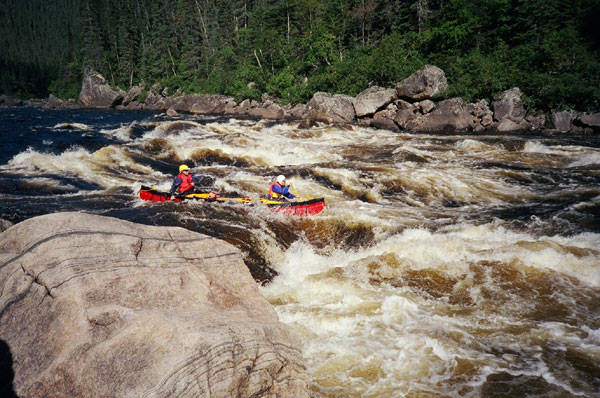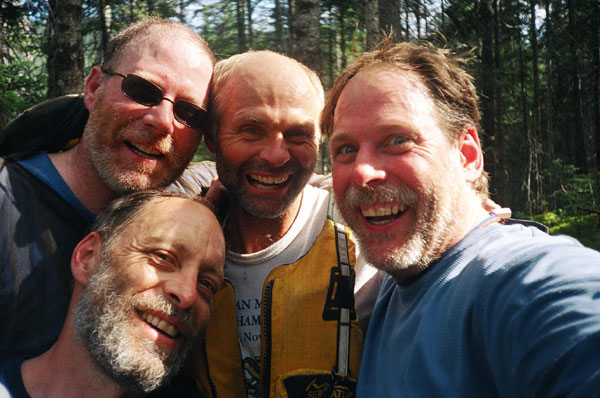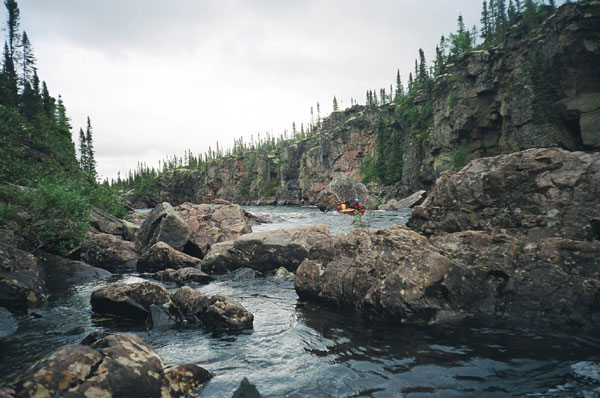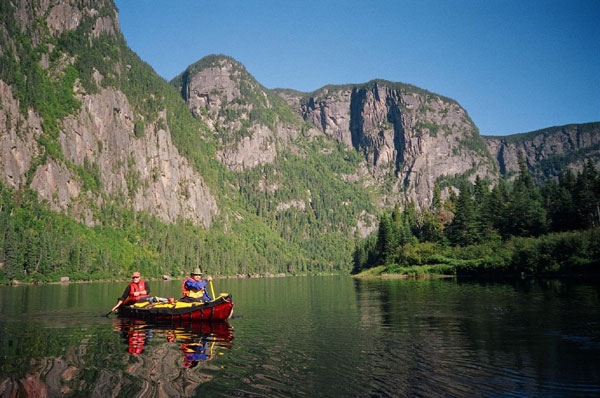Pekan Skies and Moisie Mornings
 Heartwood Homes Heartwood Homes
Pekans and Moisie River Expedition of Aug/Sept. 2004
"I think we can run this one", Peter said, as we stood on a massive boulder midway down a class
4 rapid on the Moisie River. I felt the rush of adrenaline as I imagined navigating the powerful
hydraulics we were attempting to analyze. "Yeah, I guess so..." Mike replied, "There seems to be
a clear path that skirts that hole and avoids the waves." My partner, Rick Swain, was cautious,
"Those standing waves are enormous, and if we hit the ledge at the top, we will land in the hole
below it and that will be bad!"
|

|
|
Peter Gale, Mike McMahon, Rick Swain, and myself, Rick McMahon, were 12 days into our
Pekans/Moisie River expedition of August/Sept. 2004. After two years of planning, we had
put in near Fermont, Quebec where the Pekans River crosses under the road, 375 km from the
St. Lawrence River. Many gruelling portages and exciting rapids later, we were looking at
a major challenge, 198 km from our destination near Sept Iles, Quebec.
Not long into this day's paddle, the Moisie narrowed to about 50 meters as it tumbled over
a rock pile that had fallen from the 500 meter high canyon wall. There was no real trail
through the jumble of boulders on the shore and lining the canoes along the shoreline looked
tricky. Down the center of the rapid was a clear tongue that led into a series of two meter
high standing waves. They were larger than anything we had run so far. At the top of the run
was a ledge extending from river right, creating a dangerous hole below it. With reasonably
calm water and an eddy at the bottom of the run, we decided to go for it.
Mike and Peter agreed to go first. They went back up river to their canoe while Rick clambered
over the rock pile to a good downriver rescue spot. I set up with a throw bag and a camera
on a boulder midway down. Two blasts on the whistle told us that Rick was in position and our
friends peeled out into the current.
"Throw the bag, not the camera", I reminded myself as I started snapping pictures. Mike was
in the bow, paddling on the left as they rapidly approached the ledge. "Go left, go left!" I
yelled, thinking they were too close. I watched through the camera lens, as they skirted the
ledge by a couple of feet and dropped by the edge of the hole. The 17 foot Oldtown Tripper
looked like a toy canoe beside that gaping hole as Mike pulled hard left and Peter solidly braced
and pried. They shot past the hole and into the standing waves. I snapped pictures, my heart
pounding, as our friends were tossed by waves that crashed over them and would have swamped an
open boat. They held steady and eddied out to the right.
Mike and Peter had grins so big it was hard to see their faces. "I guess it's our turn," Rick
and I said, looking wide-eyed at each other. We secured our boat, checking the spraydeck,
spare paddles, painters and throw bags. Peter and Mike bailed and stayed in their canoe for
pictures and a river rescue if necessary. Thigh straps tight, we worked our way up the eddy.
Hearts pounding, we peeled out. The current grabbed us and, as we shot downriver, a random
boil shook our boat, throwing us momentarily off balance. Everything disappeared behind the
rapidly approaching ledge on the right, and the river rose up like a living mountain range
down the center channel.
"Keep it left," I yelled as we approached the ledge. I was paddling on the right, so I pried
the bow past the ledge and hole as Rick braced hard in the stern. Our bow plunged into the
white water and shot into the standing waves. We were on a roller coaster with waves crashing
into and over us as we struggled to keep control. Powering right, we caught the eddy behind
Mike and Peter. Hooting and hollering, we grinned and laughed and all talked at once. We were
ecstatic and felt a boost in confidence as we bailed our boats and headed downriver to find
a nice place for lunch.
|

|
|
This was just one of the events that highlighted our Pekans/Moisie expedition of August/September
2004. We are four good friends, from Nova Scotia, who share a love of wilderness rivers and
whitewater paddling. Mike and Peter live on the Bay of Fundy coast in Baxters Harbour, and
they have been paddling together for many years. My partner, Rick Swain, lives on the Atlantic
coast in Prospect and he works as a nurse in nearby Halifax. He developed fine whitewater
paddling skills on the big Western Canadian rivers before coming home to raise his family
in Nova Scotia. I live in Victoria Harbour, and have gained most of my paddling skills in
the last few years, with whitewater in the spring and marathon canoe racing from April
through October.
For several years, the four of us have been teaming up for one to two-week trips in the
springtime to paddle our Nova Scotian river systems. We often talked and dreamed of northern
rivers and, finally, these dreams became a reality for us. We focused on the Moisie River
in eastern Quebec because it is accessible by road or rail at the top and bottom, but is truly
a wilderness experience in between. We chose to outfit our 17 foot Oldtown Trippers with thigh
straps and spraydecks for the journey. These 84 lb royalex canoes are tough and maneuverable
and they can handle plenty of weight. Each boat carried two 70 L barrels, two 115 L dry bags
and day packs. We had a satellite phone in one boat and an e-pirb in the other. We carried
epoxy repair and first aid kits in both.
For navigation, we used topo maps with GPS waypoints as well as an excellent set of river maps
developed by Raymond Boyer of Sept Iles, Quebec. These maps provided us with excellent
information concerning rapid classification and length, locations of portage trails, and
suggested campsites. We considered these rivers to be quite dangerous so it was imperative
that we knew exactly where we were all the time.
Safety was a major concern to us. A wilderness first aid course convinced us that we wanted
to prevent any kind of accident or emergency situation. We were careful to purify our
drinking water and to keep ourselves well hydrated at all times. Our schedule allowed us
enough time for the trip so that we were able to feel reasonably well rested most of the
time.This also allowed us the chance to savour the beauty of our surroundings. It is beautiful
country.
After a grueling drive up the Labrador highway, with five of us jammed into a crew cab truck,
we set up camp on a sandy beach at our starting point. Our good friend Barry Squires then
drove the truck 600 km south to Sept Iles where he caught a flight home. We had originally
planned to send the truck by train from nearby Labrador City but, due to a strike at the mine,
the trains were not running. Thank you, Barry!
|

|
|
The Pekans River, where we joined its flow, is wide and lake-like in the sparcely treed taiga
of Northern Quebec. Deep moss cushions the ground and sandy eskers line the river as it winds
south through the gentle landscape. There are long stretches of flat water interrupted by
rapids and ledges, from class one to five, with the odd waterfall along the route.
The portage trails were, as a rule, pretty easy to locate. They ranged from "not too rugged" to
"pretty darn tough". Most of these trails begin "right on the brink of destruction" so good
paddling skills are needed to navigate a class 2 rapid while looking for a trail on the left,
pretty close to the yawning maw of a class 5 ledge. Our challenge was to accurately read the
river, choose a route, and then execute the procedure. We were pleased to find that most
rapids could be scouted from the boat and that there was plenty of water to allow clear passage
in the deep water channels. Our heavily laden canoes performed well in the big water and we
were very happy with the spraydecks as a lot of the class 3 rapids could have easily swamped
an open boat. We spent six days on the Pekans, with a two night stay at km 298 just above
the 1700 m portage down to the Moisie River. The Pekans plunges about 125 m over the last
few km before joining the Moisie and the portage trail is at times rugged and steep. We spent
the better part of a day making our three trips and did a tandem carry and drag over most of
the trails. I think that this lessened the probability of injury.
Finally, we were on the Moisie River. Flowing through a distinct valley, it is larger, deeper,
and more powerful than the Pekans. The scattered black spruce of the taiga is replaced by a
dense forest of spruce, fir, and the occasional white birch. The river flows at a swift 7
km/h on the flat stretches and it accelerates to over 20 km/h in some rapids. There are large
standing waves in the R 2's and 3's. The portage trails get steeper with room for only one
boat at many of the take out and put in places. There are spectacular waterfalls and cliff
faces and ledges. The white water paddling was a dream come true, with sometimes several
km's of R 1, 2 and 3's in various exciting combinations. Other days were "portage hell",
with class 4 and 5 rapids or ledges every few kilometers down the river. The hills increased
in height as we travelled, with canyon walls rising sometimes to 1600 feet above the water.
Some sections of the Moisie are so spectacular that we were in a constant state of awe from
the beauty that surrounded us.
There are hunting camps along the route that are unlocked and welcoming to the travelling
public, who use them with great respect and thanks. The logbooks in these places gave us a
glimpse of our fellow adventurers, who they were, where they were from, and how they were
fulfilling their dreams, as were we.
One of the highlights of our portage adventures was the Fish Ladder Portage. The trail "a droite"
is very steep up for a long way, flat along the top for a while and then steep down for another
distance, to a maze of rock piles with bear scat on the path. Finally, it empties onto the beach,
amongst a group of cabins belonging to the Quebec Government. There are helicopter pads,
boardwalks, and a concrete fish ladder around the "chute". The four of us teamed up on each
canoe to push, pull, and sweat the 84 lb beast up that hill and collapse in a heap at the
top. We heard later that the "gauche" side is easier.
Below the fish ladder, there are some fancy fishing lodges that close down in early September.
There were plenty more rapids to run, more great scenery, and, on our last day...the famous
Trestle rapids.
|

|
|
Journal Entry Tues. September 14, km 32, Day 18
"We had an early start from our last, beautiful campsite. Cloudy but not raining. Good breakfast,
boats tight and much lighter than 18 days ago. Around the first bends, the R 5 was imposing so
we portaged our boats and gear over the flat, scoured rockscape. Looked in awe at the tremendous
hydraulics created by this mighty river pouring through a smallish gap. On the river again, we
had our eyes wide open as we hit a series of R 2, 3, and 4 in pretty quick succession with some
pools in between. R3-4 before the trestle was 800 m. We punched through the biggest standing
waves I've ever paddled in and I had waves hitting me with great force and actually breaking
over my head. Series of diagonal waves tossed our boat like a little puppy dog, but we held her
steady and plunged right on through. We bailed when we hit an eddy or pool and then ran the next
series. Coming around the bend at the trestle, the water piles up hard on the right bank so we
needed to work left to avoid the "drossage". One more R3 past the trestle and we were finished
with the white water on the mighty Moisie River. We stopped for tea and lunch, wrung out our wet
gear and rejoiced in making a safe and upright run down the Pekans and the Moisie. Good teamwork
and communication on the river allowed us to drop eddy to eddy and scout most rapids from the
boats to allow for safe and efficient passage downriver. After the Trestle Rapids we had a long,
calm paddle, in no winds down the placid Moisie for the last 12 km. to the campground by the
bridge. The river is divided into sectors for salmon fishing and is well populated with camps
as it nears the St. Lawrence River."
The weather for our trip was rainy at first but, most days, we experienced a wide range of
conditions. On September 2, we had a frosty morning, spectacular sunrise, snow flurries
turning into light rain showers, and some sunshine. Generally speaking, if we opened a dry
bag and spread stuff out on the ground, it would start to rain. The water temperature on the
Pekans was 14 degrees C and dropped to 12 degrees on the lower Moisie. We had nice weather
for most of the last two weeks and, some days, there was not a cloud in the sky. I think that
this may be unusual. The blackflies were, at times, pretty intense, but they backed off whenever
the temperature dropped below about 12 degrees C.
This trip was, in many ways, a voyage of discovery for me. Not only was it new country, but it
was also the longest self contained expedition of which I have been a part. We are four good
friends who have travelled together before, but we are also four different personalities with
individual ways of doing things, and our own personal goals. There was plenty of "give and take"
on everybody's part as we attempted to satisfy our own personal agendas without interfering with
those of our friends. To maintain group integrity, decisions were made by consensus, with
respect for individual needs.
After 18 beautiful days in the wilds of Quebec, we found ourselves back in the "civilized"
world. So ended a great adventure that whets the appetite for more.
Rick McMahon
 Heartwood Homes
Heartwood Homes
|